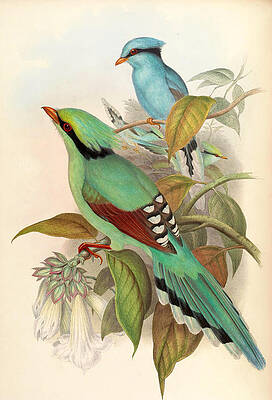Superregnum: Eukaryota
Regnum: Animalia
Subregnum: Eumetazoa
Cladus: Bilateria
Cladus: Nephrozoa
Superphylum: Deuterostomia
Phylum: Chordata
Cladus: Craniata
Subphylum: Vertebrata
Infraphylum: Gnathostomata
Superclassis: Tetrapoda
Cladus: Reptiliomorpha
Cladus: Amniota
Classis: Reptilia
Cladus: Eureptilia
Cladus: Romeriida
Subclassis: Diapsida
Cladus: Sauria
Infraclassis: Archosauromorpha
Cladus: Crurotarsi
Divisio: Archosauria
Subsectio: Ornithodira
Subtaxon: Dinosauromorpha
Cladus: Dinosauria
Ordo: Saurischia
Cladus: Theropoda
Cladus: Neotheropoda
Infraclassis: Aves
Ordo: Passeriformes
Subordo: Passeri
Parvordo: Corvida
Superfamilia: Corvoidea
Familia: Corvidae
Genus: Cissa
Species: Cissa chinensis
Subspecies: C. c. chinensis – C. c. klossi – C. c. margaritae – C. c. minor – C. c. robinsoni
Name
Cissa chinensis (Boddaert, 1783)
Synonyms
Coracias chinensis (protonym)
Cissa chinensis, Henry Constantine Richter
References
Table des Planches Enluminéez d'Histoire Naturelle de M. D'Aubenton: 38 #620.
Vernacular names
বাংলা: পাতি সবুজতাউরা
čeština: Kraska zelenavá
dansk: Grøn Jagtskade
Deutsch: Jagdelster
English: Common Green Magpie
Esperanto: Verda pigo
español: Urraca Verde
eesti: Roheharakas
suomi: Viherharakka
français: Pirolle verte
magyar: Zöld kitta
Bahasa Indonesia: Ekek Layongan
italiano: Gazza verde
日本語: ヘキサン
latviešu: Zaļā žagata
Bahasa Melayu: Burung Gagak Gunung
Nederlands: Groene Kitta
norsk: Grønnskjære
polski: Kitta szmaragdowa
پنجابی: ہرا سیانا کاں
русский: Зёленая сорока
slovenčina: Straka zelená
ไทย: นกสาลิกาเขียว
Tiếng Việt: Giẻ cùi xanh
中文: 蓝绿鹊
The common green magpie (Cissa chinensis) is a member of the crow family, roughly about the size of the Eurasian jay or slightly smaller. In the wild specimens are usually a bright green colour (often fades to turquoise in captivity or with poor diet as the pigment is carotenoid based[2]), slightly lighter on the underside and has a thick black stripe from the bill (through the eyes) to the nape. Compared to the other members of its genus, the white-tipped tail is quite long. This all contrasts vividly with the red fleshy eye rims, bill and legs. The wings are reddish maroon.
It is found from the lower Himalayas in north eastern India in a broad south easterly band down into central Thailand, Malaysia, Sumatra and northwestern Borneo in evergreen forest (including bamboo forest), clearings and scrub.
This bird seeks food both on the ground and in trees, and takes a very high percentage of animal prey from countless invertebrates, small reptiles, mammals and young birds and eggs. It will also take flesh from a recently killed carcass.
The nest is built in trees, large shrubs and often in tangles of various climbing vines. There are usually 4–6 eggs laid.
The voice is quite varied but often a harsh peep-peep. It also frequently whistles and chatters.
Taxonomy
In bluish plumage, Kaeng Krachan National Park, Thailand
The common green magpie was described by the French polymath Georges-Louis Leclerc, Comte de Buffon in 1775 in his Histoire Naturelle des Oiseaux.[3] The bird was also illustrated in a hand-coloured plate engraved by François-Nicolas Martinet in the Planches Enluminées D'Histoire Naturelle which was produced under the supervision of Edme-Louis Daubenton to accompany Buffon's text.[4] Neither the plate caption nor Buffon's description included a scientific name but in 1783 the Dutch naturalist Pieter Boddaert coined the binomial name Coracias chinensis in his catalogue of the Planches Enluminées.[5] Buffon believed that his specimen had come from China but the species only occurs in the extreme south of the country. The type locality was redesignated in 1952 by the German ornithologist Erwin Stresemann as Mergui, Tanintharyi Region, Myanmar.[6]
The common green magpie is now one of four species that are placed in the genus Cissa that was introduced by the German zoologist Friedrich Boie in 1826 with the common green magpie as the type species.[7][8] The generic name is from the Ancient Greek kissa meaning a "jay" or "magpie". The specific epithet chinensis was chosen by Boddaert in the mistaken belief that the specimen illustrated by Martinet had come from China.[9]
Five subspecies are recognised:[8]
C. c. chinensis (Boddaert, 1783) – Himalayas to south China, north Indochina, Thailand and Myanmar
C. c. klossi Delacour & Jabouille, 1924 – central Indochina
C. c. margaritae Robinson & Kloss, 1919 – Lang Bian Mountains (south Vietnam)
C. c. robinsoni Ogilvie-Grant, 1906 – Malay Peninsula
C. c. minor Cabanis, 1850 – Sumatra and Borneo
References
BirdLife International (2012). "Cissa chinensis". IUCN Red List of Threatened Species. 2012. Retrieved 26 November 2013.
Shelton, L. C. "Successful Breeding of the Long--tailed Cissa at the Houston Zoo". AFA Watchbird. 16 (5): 8–11.
Buffon, Georges-Louis Leclerc de (1775). "Le rolle de la Chine". Histoire Naturelle des Oiseaux (in French). Volume 5. Paris: De L'Imprimerie Royale. pp. 181–182.
Buffon, Georges-Louis Leclerc de; Martinet, François-Nicolas; Daubenton, Edme-Louis; Daubenton, Louis-Jean-Marie (1765–1783). "Rollier, de la Chine". Planches Enluminées D'Histoire Naturelle. Volume 7. Paris: De L'Imprimerie Royale. Plate 620.
Boddaert, Pieter (1783). Table des planches enluminéez d'histoire naturelle de M. D'Aubenton : avec les denominations de M.M. de Buffon, Brisson, Edwards, Linnaeus et Latham, precedé d'une notice des principaux ouvrages zoologiques enluminés (in French). Utrecht. p. 38, Number 620.
Stresemann, Erwin (1952). "On the birds collected by Pierre Poivre in Canton, Manila, India and Madagascar (1751–1756)". Ibis. 94 (3): 499–523 [516]. doi:10.1111/j.1474-919X.1952.tb01847.x.
Boie, Friedrich (1826). "Generalübersicht der ornithologischen Ordnungen, Familien und Gattungen". Isis von Oken (in German). 19. Cols 969–981 [975 Fn. 2].
Gill, Frank; Donsker, David, eds. (2019). "Crows, mudnesters, birds-of-paradise". World Bird List Version 9.2. International Ornithologists' Union. Retrieved 25 August 2019.
Jobling, James A. (2010). The Helm Dictionary of Scientific Bird Names. London: Christopher Helm. pp. 101, 109. ISBN 978-1-4081-2501-4.
Retrieved from "http://en.wikipedia.org/"
All text is available under the terms of the GNU Free Documentation License


